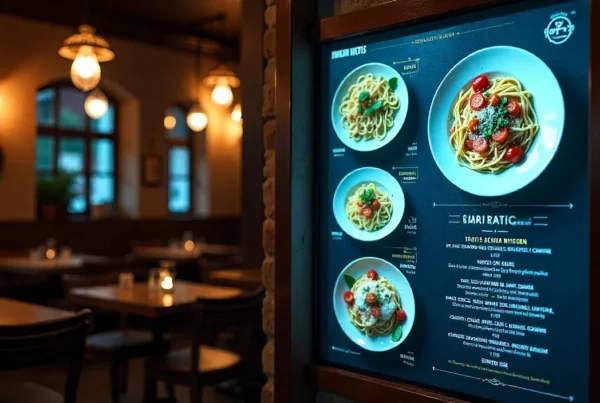The supermarket isn’t just a place to buy essential items; the supermarket is evolving as an immersive retail space where people go and are engaged with newer and more efficient communication and better-personalized experiences. Given that modern consumers expect more from their shopping trips, retailers are increasingly looking to supermarket digital signage to improve in-store experiences, improve operations and increase sales.
It has its limitations on the traditional static posters and printed advertisements. They are rigid, need frequent updates and don’t attract consumer’s attention the way digital content does. For grocery stores, supermarkets having digital signage allow stores to convey promotions and product details in a visually dynamic and flexible manner, like an interactive wayfinding system and real-time updated prices. This is becoming the norm for supermarkets that want to improve customer interactions and stay competitive in the new retail environment.
The Evolution of Retail Marketing and the Rise of Digital Signage

It is within the recent past that retail marketing has made a drastic change. The displays of newspapers, flyers and billboards have been overpowered by digital displays and AI-based marketing strategies. With the requirement of engaging, real-time communication with customers, supermarkets are gradually shifting to digital signage solutions. Digital displays in grocery stores are recognized as more than advertisements; it is tools for educating, directing, and informing customers and, at the same time making money.
One of the most important uses of digital signage in supermarkets is that they are high-traffic places, and being there, customers need to be informed about special promotions, store policies, where to find a product or real-time discounts. It could be strategically placed video wall by the entrance or shelf edge displays promoting the limited time offers to name a few, but the real thing about digital signage is it creates an engaging shopping experience that print media cannot offer.
What is Supermarket Digital Signage and How Does It Work?
Digital signage in supermarkets is electronic displays used to transmit targeted messages and promotional content and assist in-store navigation. These systems are updated in real-time with digital signage software to keep content, such as ads, prices and promotions, current and useful. Unlike static printed signs, digital signage for supermarkets is infinitely customizable and can be changed remotely as per customer demographics, peak shopping hours, seasonal trends, etc.
This technology generally consists of different kinds of displays, such as big in-store advertising screens, and digital signage for grocery stores and supermarkets located at the checkout counter, on the product shelves or even on shopping carts. In addition, a few stores use interactive touchscreens that allow customers to go through product catalogues, find products within the store, and individualize shopping recommendations according to purchase history.
The inclusion of digital signage solutions for supermarket environments offers the possibility for retailers to enhance their inventory management, highlight in-house brands, and boost the entire engagement level by providing content matched for the target audience.
Why Supermarkets Are Embracing Digital Signage

Digital signage is one of the biggest advantages for supermarkets as it is able to transform how stores are able to communicate with customers. Supermarkets get to influence customer purchasing behavior in real-time by utilizing bright, attention-grabbing displays. A digitally placed screen can have discounts or product recommendations strategically placed for shoppers to explore new brands or promotions that they might have never seen.
Besides marketing, digital signage brings about a significant improvement in operational efficiency. Internal communication is another example of a problem you can solve with in-store digital signage; they can display schedules for staff, restock notifications, etc, for a grocery store. The benefit of this is that it reduces the need for printed notices, makes work easier for employees and ultimately offers better shopping experience for customers.
Another reason why supermarkets are opting for digital signage for supermarket marketing is cost-effective. Even though the first investment may be higher compared to traditional signage, there is no need to print it anymore. The fact is that supermarkets no longer have to shell out thousands of dollars on promotional posters that are outdated in a matter of weeks. The beauty of digital signage is that it can be changed on the spot so that promotional material will always remain fresh, relevant and up to date.
The Impact of Digital Signage on Customer Experience
Grocery shopping in the modern world is all about convenience, and the best digital signage system for supermarkets helps in providing a seamless, entertaining shopping experience to customers. Store entrance includes a quick overview of live shop promotions through digital screens and a usable way to find signage for customers to navigate around the big supermarket layout without any confusion. These features not only satisfy the customer but also keep him in the store for a longer time and spend more.
Digital signage has also been a great help for checkout areas. Instead of being helpless as they stare at static price boards or wait in an impatient line, customers can now interact with digital providers that can suggest last-minute promotions, store events to come or loyalty information. It will cut down the perceived waiting times and keep the customers entertained, which could ultimately lead to repeat visits.
Real-time analytics, in this case, enables the supermarket to use digital signage solutions for supermarkets to quantify customer interactions and adjust the content strategy as well. If some promotions don’t perform, they can be substituted in seconds for extremely responsive marketing.
How Supermarkets Use Digital Signage to Increase Sales
Digital signage stands out in supermarkets because it effectively stimulates customers to make unplanned purchases. Supermarkets achieve better buying by positioning digital screens next to their high-profit items, such as snacks, beverages and seasonal products. Well-positioned digital displays lead to 30% higher item sales when they advertise desired products to consumers.
Digital signage serves as a vital tool for supermarket businesses to promote both secondary product selection through cross-selling and the advancement of higher-priced products through upselling. A bakery section with digital menu boards can use promotional combos by offering discounted coffee and pastry packages. A shelf-edge display serves as a tool to recommend additional products by displaying wine selections suitable for gourmet cheeses. Retailers achieve enhanced revenue streams through digital signage systems that carefully guide customer buying choices in grocery stores and supermarkets.
The ability to adjust prices automatically stands as a primary benefit. Retailers operating supermarkets with digital signage systems can modify prices automatically to match customer needs, inventory availability, and daily periods. The immediate markdown of fresh produce allows supermarkets to eliminate waste by selling it quickly and generating continued profitability.
Future Trends in Supermarket Digital Signage

Primary supermarkets increasingly benefit from advanced technologies which create new options for automated operations while improving customer engagement in their digital signage platforms. AI technology delivers personalized promotional campaigns as one of the current industry developments. Digital signage employs customer shopping analysis to develop intended advertisements that match personal consumer interests. The system shows organic food promotions to shoppers who visit this section but displays healthy snack recommendations to customers in the different sections.
Shelf intelligence stands out as an important innovation that allows price tags and advertising screens to modify prices and promotions using stock availability and consumer patterns. The digital shelves both display current pricing information and work with mobile applications to provide extra product details through QR code scanning as well as special discounts.
The technology of augmented reality (AR) shopping experiences begins to appear in supermarket environments. Customers will soon use their smartphones to aim at products for instant access to interactive materials, including cooking guidance, radiant origins, and product evaluation features.
The rising need for sustainable digital retail advertising solutions will lead supermarket chains to adopt LED technology with solar-powered signage as standard practice, thus decreasing their environmental footprint in advertising.
Embrace the Future of Supermarket Marketing
Modern retail marketing strategies find their leading direction through supermarket digital signage, which drives the evolution of the grocery industry. Supermarkets that choose superior digital signage systems will achieve increased customer involvement and operational efficiency as well as elevated sales numbers. Digital signage represents a fundamental requirement for supermarkets seeking digital leadership in the contemporary market because it offers live content management along with bespoke advertising offers and dynamic retailer interactions.
The time has arrived to purchase leading-edge digital signage solutions for your supermarket if you aim to transform your marketing approach. Take the field to a new shopping experience through increased sales potential that will establish your store as the industry leader. You are now prepared to recognize the future of grocery shopping.
Frequently Asked Questions (FAQs)
What is supermarket digital signage?
Supermarket digital signage refers to electronic displays used in grocery stores to showcase promotions, product details, real-time pricing, and navigation assistance, enhancing customer experience and boosting sales.
How does digital signage benefit supermarkets?
It improves customer engagement, increases impulse purchases, streamlines store operations, reduces printing costs, and allows real-time updates for promotions and pricing adjustments.
Can digital signage integrate with supermarket POS systems?
Yes, modern digital signage solutions seamlessly integrate with POS systems to display live pricing, inventory updates, and personalized promotional content.
How much does it cost to implement digital signage in a supermarket?
Costs vary based on screen type, software, and installation. Small stores may start with a few thousand dollars, while large chains invest significantly in enterprise-grade solutions.
What types of content work best for supermarket digital signage?
High-resolution product images, motion graphics, real-time pricing updates, promotional offers, and interactive wayfinding screens are the most effective content types for engaging shoppers.





